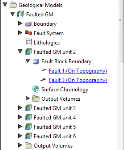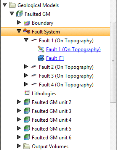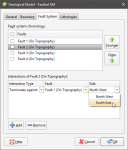Faulted Models
This topic describes how to use the fault system to create and organise faults:
- The Fault System
- Fault Interactions
- Activating the Fault System
- Copying the Surface Chronology to an Empty Fault Block
- Faulted Model Display Options
Each geological model is created with a Fault System object that is used to construct faults. Once the faults are active in the geological model, the geological model will be divided into separate fault blocks, which will appear in the project tree as part of the model:
Each fault block has its own Surface Chronology, which can be modified without affecting other fault blocks in the geological model. There is no top-level Surface Chronology for the geological model once the Fault System has been activated. This means that lithology layers can be constructed for a faulted model in two ways:
- Define the Surface Chronology before enabling the Fault System. All surfaces defined for the unfaulted model will automatically be copied to each fault block. Some surfaces defined for the model as a whole will not occur in every fault block, which can be corrected by working with the surfaces in each fault block.
- Enable the Fault System before any surfaces are defined in the unfaulted model, then define the Surface Chronology for each fault block. An aid to working with a faulted model in this way is the ability to copy contact surfaces from one faulted block to another. See Copying the Surface Chronology to an Empty Fault Block below.
Which approach is best depends on the model being built. You may already know where the faults are and choose to define them and subdivide the geological model before defining any lithology layers. On the other hand, sometimes it is not apparent where the faults are until the layers have been built, in which case you can add the new fault, activate it in the model, then work with the surfaces in each fault block.
The Fault System
When a geological model is first created, the Fault System object is empty. To create faults, right-click on the Fault System object and select from the options available. Many of these options are similar to those for creating lateral extents. For more information, see:
- Extent From a Polyline
- Extent From GIS Vector Data
- Extent From Points
- Extent From Structural Data
- Extent From a Surface
Faults created from polylines and GIS vector data can be created as vertical walls or surfaces. Faults created as surfaces can be modified by adding further data, as described in Editing Faults.
Creating a fault from the base lithology or other contacts is similar to creating contact surfaces. See Deposits and Erosions From the Base Lithology and Deposits and Erosions From Other Lithology Contacts for more information.
Faults will appear in the project tree as part of the Fault System object and can be expanded to show how they were created:
Once faults have been created, you can modify them as described in Editing Faults.
Fault Interactions
Once all the faults required have been created, you can start defining the interactions between the faults by double-clicking on the Fault System object. The Geological Model will be opened with the Fault System tab displayed:
To add an interaction, click on a fault, then click the Add button. Select the Interaction Type and set how the faults interact:
Once you have defined each fault interaction, click OK to generate the fault system. Add the Fault System object to the scene to check that the faults interact correctly.
You can also edit fault interactions by double-clicking on individual faults. The Edit Fault window will open, which shows only the interactions for the selected fault:
Faults are not active in the geological model until the box is ticked for each fault in the Fault System window, as described in Editing Faults. This means you can check the fault system without regenerating the geological model.
Activating the Fault System
Activating the fault system divides the geological model into fault blocks, which can result in considerable processing time for complex models. It is important, therefore, to define fault interactions before enabling the fault system, otherwise a large number of fault blocks could be generated that significantly increase processing time. See Fault Interactions above.
To activate the fault system in the geological model, double-click on the Fault System object once again and tick the box for each fault. The model will be divided into separate fault blocks that can be worked with in a similar manner to the geological model as a whole.
Copying the Surface Chronology to an Empty Fault Block
If you are working with a faulted model and have defined the Surface Chronology for one fault block, you can copy the Surface Chronology to the empty fault blocks. To do this, right-click on the Surface Chronology for which you have defined surfaces and select Copy Chronology To. In the window that appears, select the fault blocks you want to copy contacts to and click OK. The surfaces will be copied and you can modify them without affecting the surfaces in the other fault blocks.
Faulted Model Display Options
Drag the model into the scene or right-click on it and select View Object; these options add the model to the shape list as a single object and you can change the visibility of each lithology by clicking the Edit Colours button. You can also add the model to the scene as a series of output volumes by right-clicking on the model and selecting View Output Volumes.
Another display option lets you view the individual fault blocks without displaying the lithology layers. Right-click on the model and select View Fault Block Boundaries.
To work with a specific fault block, click on it in the scene. The window that appears displays the name of the selected fault block:
You can also view the output volumes for each individual fault block by right-clicking on the fault block in the project tree and selecting View Output Volumes.
Got a question? Visit the Seequent forums or Seequent support





